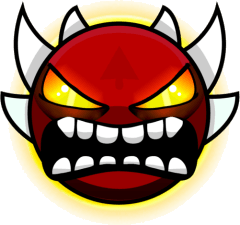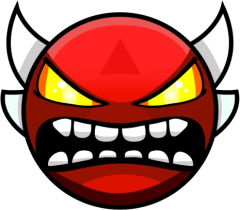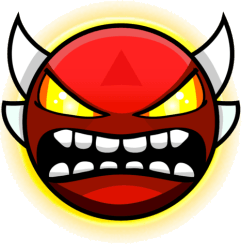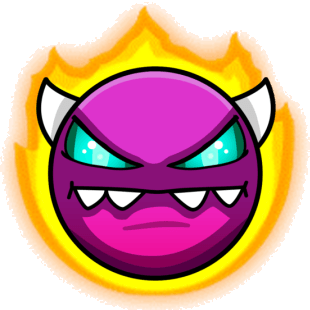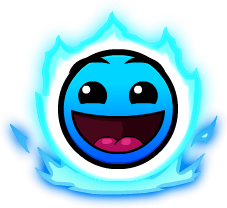Banned
Rating Curve
Filters
Reviews
"Apocalyptic Trilogy" by APTeamOfficial is nothing short of an epic masterpiece. Spanning a hefty 280 seconds, this level serves as a monumental tribute to some of the most legendary and iconic levels in Geometry Dash history. Featuring remakes of Cataclysm by Ggb0y, Bloodbath by Riot, and Aftermath by Exenity, the level takes players on a rollercoaster ride through three of the hardest and most impactful levels in the game’s history, all while maintaining a perfect sense of continuity and breathtaking difficulty.
Visually, Apocalyptic Trilogy is a feast for the eyes. The level evolves with each section, transitioning smoothly from one legendary design to the next. The opening third, a faithful remake of Cataclysm, brings back the terrifying, fast-paced intensity of the original, with its iconic fiery, chaotic colors and tight gameplay. The second section, inspired by Bloodbath, ups the ante with even more aggressive decoration, dark, high-contrast color schemes, and visually complex effects that perfectly capture the heart-pounding challenge of Riot’s creation. The final third, a take on Aftermath, brings everything to a head with a polished, more fluid design, blending sleek aesthetics with complex gameplay mechanics. Each section feels distinct yet connected, creating an almost cinematic experience that flows from one legendary challenge to the next.
The gameplay is the real standout of Apocalyptic Trilogy, and APTeamOfficial has done an exceptional job of maintaining the integrity of the original levels while adding their own modern touch. Each third of the level is designed to match the exact pacing and difficulty of the original levels but with smoother transitions, more refined mechanics, and subtle enhancements to make sure the level feels fresh without losing that brutal challenge fans love. The Cataclysm section is fast and punishing, while Bloodbath’s portion is precision-heavy and unforgiving, and the Aftermath segment features expertly timed jumps that demand both skill and memorization. This makes it a challenging but rewarding experience that will leave even the most seasoned players feeling accomplished.
The choice of At the Speed of Light by Dimrain47 as the soundtrack is the cherry on top. This track, known for its intense pace and electrifying energy, fits perfectly with the high-stakes intensity of the level. The song provides a pulsating rhythm that keeps you engaged, amplifying the level’s already relentless pace. Every beat syncs beautifully with the gameplay, making the whole experience feel like you’re racing against time and intensity.
The dedication to both visual design and gameplay mechanics in Apocalyptic Trilogy is evident in every section. APTeamOfficial has crafted a love letter to the toughest levels in Geometry Dash history, blending them into a single cohesive experience that not only feels like a challenge but also a triumph of creativity. From the first drop to the final moments, Apocalyptic Trilogy is an absolute adrenaline rush, offering a fresh take on the classics while paying respect to their roots.
10/10. A flawless tribute to the legends of Geometry Dash, packed with adrenaline and pure thrill.
“Magic Life” by Astraa is a stunning homage to the iconic level High Life by Migueword, breathing new life into an already beloved classic. Clocking in at a generous 260 seconds, Magic Life doesn’t just remake the original—it improves upon it in nearly every aspect, delivering a refreshing yet nostalgic experience. Paired with the smooth, vibrant track “Magic Touch” by Romos, this level creates a journey that’s both visually captivating and rhythmically engaging.
Visually, Magic Life is a feast for the eyes. It embraces a bright, colorful aesthetic that perfectly matches the upbeat, feel-good vibe of the song. Astraa has taken the original High Life and enhanced it with sleek decoration, dynamic lighting, and clever visual effects that amplify the energy without overwhelming the player. The level transitions smoothly between sections, with each area offering its own unique atmosphere, but always maintaining that signature, uplifting flow that fans of High Life will immediately recognize.
The gameplay in Magic Life is where Astraa shines, perfectly balancing challenge with accessibility. While it retains much of the original layout from High Life, it refines the difficulty and flow, making each jump and transition feel smoother and more intuitive. The ship and wave sections are particularly satisfying, with tight controls and well-timed sync to the music. There’s a great sense of progression, where each new section builds on the previous one, but never feels too overwhelming. It’s a level that rewards precision and timing but never crosses into unfair territory, making it a joy to play through.
The choice of music—Magic Touch by Romos—couldn’t be more perfect for this level. The track has a laid-back, upbeat rhythm that flows seamlessly with the level’s structure. The soft, melodic beats build up progressively, perfectly aligning with the gameplay’s ebb and flow. Every section of the level is carefully synced to the music, making every jump feel purposeful and satisfying. The track gives the level a sense of freedom and lightness, and its upbeat tempo keeps you fully immersed in the experience.
What sets Magic Life apart from other remakes is its ability to evoke nostalgia while still feeling fresh and exciting. It honors the original High Life while adding enough new elements to make it feel like its own, unique adventure. Astraa’s creativity and attention to detail shine through, making this a must-play for fans of both the original and those who are new to the level.
10/10. A perfect remake with a magical, memorable journey.
“too kiD frIEndly” by ExtoPlasm is a surreal, mind-bending 210-second fever dream that throws all traditional level design out the window—and it’s absolutely glorious. From its cryptic title to its unhinged pacing, this level is a chaotic statement piece, a genre-defying rollercoaster that leaves you laughing, confused, and oddly inspired all at once.
Visually, too kiD frIEndly lives in a world of deliberate contradiction. The art style shifts wildly from childish cartoon simplicity to glitchy horror-core madness within seconds, often blending both at once. It’s like someone mashed up a kid’s TV show with a corrupted VHS tape—and somehow it works. Hand-drawn sprites, meme inserts, clashing fonts, weird zoom-ins—everything screams irony, but it’s done with such style and control that you can’t look away.
The gameplay is as wild as the visuals. You’ll go from slow, laughably easy jumps to lightning-fast precision segments without warning. There are sudden changes in speed, gravity, size—you name it—and yet it somehow never crosses into completely unplayable territory. In fact, the unpredictability becomes part of the charm. It dares you to keep going just to see what absurdity comes next. And with over 3 minutes of content, there's a lot of absurdity to survive.
What really sets this level apart, though, is its personality. too kiD frIEndly doesn’t take itself seriously—but it also knows exactly what it’s doing. It plays with your expectations, pokes fun at GD tropes, and dances right on the edge of madness without ever falling off. It’s chaotic, yes—but it’s intentionally chaotic. Every visual gag, troll segment, or jarring audio cut feels like part of a bigger inside joke that you’re slowly being let in on.
It’s not just a level—it’s a digital performance piece. A satirical, self-aware love letter to everything bizarre, broken, and brilliant about the Geometry Dash community.
10/10. Too weird to describe, too good to miss.
“Dead Device” by IMOXI is a creative powerhouse that pays homage to Geometry Dash’s legacy while forging a bold, chaotic path of its own. As a full-blown remake of the official level “Deadlocked,” this beast doesn’t just revamp the original—it completely reimagines it. And with heavy inspiration drawn from the infamous “Rage Quit” by bli, Dead Device becomes a love letter to pure madness, wrapped in a polished, high-energy package.
Visually, the level is explosive—intense effects, rapid transitions, and a glitchy, unstable aesthetic that gives the whole thing a feeling of barely-contained digital chaos. It’s Deadlocked, but torn apart, twisted, and thrown into overdrive. You’ll recognize pieces of the original layout, but they’re hidden beneath layers of visual noise, sudden warps, and mechanical insanity that keeps you on edge from start to finish.
The influence of Rage Quit is felt in the gameplay design: unpredictable, intentionally disorienting, and aggressively fast. But unlike Rage Quit, which often teeters into unfair territory, Dead Device stays just grounded enough to be beatable—if you’ve got sharp reflexes and the patience of a machine. Sudden gravity flips, split-second inputs, and deceptive portal placements are all part of the ride, but it never feels lazy or cheap. It’s calculated chaos.
What really makes Dead Device shine is how it blends frustration with fun. It’s challenging, yes—sometimes brutally so—but it’s also exciting, addictive, and packed with character. IMOXI clearly understands both the art of remixing and the thrill of punishing gameplay. The level constantly throws new tricks at you, keeping you guessing and hyped all the way to the final spike.
As a remake, it honors Deadlocked. As a tribute, it echoes Rage Quit. But as a standalone experience, Dead Device is a high-voltage nightmare machine—and a total blast to play.
10/10. A chaotic masterpiece born from nostalgia and pure adrenaline.
“Stereo Madness V4” by Bowser is an unapologetic sensory overload—and somehow, that’s exactly what makes it brilliant. Taking the most recognizable level in Geometry Dash and transforming it into a wild, chaotic, epilepsy-inducing remix is a bold move, but Bowser doesn’t hold back for even a second. This level isn’t just a visual storm—it’s a full-blown experience.
From the moment it begins, you’re hit with an explosion of flashing lights, screen shakes, wild color transitions, and particle effects that would make even the calmest player grip their mouse in fear. It’s loud, it’s unpredictable, and it knows it’s too much—and that’s kind of the point. It’s a parody, a celebration, and an escalation of everything that defines Geometry Dash at its most extreme.
The gameplay, despite all the madness, is surprisingly solid. It takes the original “Stereo Madness” layout and cranks up the difficulty, layering in fake-outs, fast-paced transitions, and tight timing while still maintaining a clear rhythm. The level syncs to the music in a way that makes the chaos feel oddly controlled—like you’re barely hanging on, but it wants you to survive, just barely. That balance between overwhelming visuals and surprisingly playable design is what makes “Stereo Madness V4” so addictive.
But the real genius of the level lies in its commentary. It feels like a meta take on the community’s obsession with remixes, difficulty inflation, and over-the-top visual effects. It’s self-aware, ridiculous, and somehow still respectful of the original level it’s riffing on. You can’t help but laugh, scream, and admire it all at once.
10/10. A glorious, chaotic tribute to Geometry Dash culture.
“Rest in Peace” by PICAAAAAA is more than just a Geometry Dash level—it’s a heartfelt tribute to a legend. Dedicated to Michigun, one of the most iconic players and creators in the game’s history, this level stands as a moving celebration of his legacy and the deep impact he had on the community. From the first click to the final portal, it’s clear this was made with care, love, and deep respect.
Visually, “Rest in Peace” walks a fine line between nostalgia and solemn beauty. It pays homage to Michigun’s signature style—tight wave corridors, symmetrical layouts, and classic block design—but filters it through a modern lens. The deco doesn’t try to outshine the meaning behind the level; instead, it enhances it. Subtle lighting, glowing outlines, and symbolic structures (like angel wings, candles, and silhouettes) are used thoughtfully, never overdone. The somber atmosphere is matched perfectly with the soundtrack, which is calm, emotional, and beautifully synced throughout.
Gameplay-wise, the level feels like a journey—a reflection. It’s not overly flashy or brutally difficult. Instead, it strikes a respectful balance: challenging enough to honor Michigun’s skill-based roots, but accessible enough to be experienced by many. It flows smoothly, each section gently transitioning into the next, like chapters in a story. There's a noticeable evolution throughout the level, both visually and mechanically, as if you're walking through his history—his early works, his iconic design choices, and the quiet reverence that followed his passing.
But what really makes “Rest in Peace” stand out is the emotion. This is a level you feel. From the subtle nods to Michigun’s legacy, to the quiet fadeout at the end, it captures something rare in a game built on spikes and timing: genuine human connection. It reminds you that behind every level, every creator, and every name on a leaderboard, there’s a person, a story, a life.
PICAAAAAA did something special with this one.
10/10. A beautiful tribute to a beloved legend.
“Lit Fuse” by KrmaL is a high-octane masterclass in intensity, pacing, and pure adrenaline. Clocking in at 161 seconds, this level doesn’t just maintain its energy from start to finish—it amplifies it. KrmaL has always been known for pushing boundaries, and “Lit Fuse” is no exception. It’s chaotic, controlled, and completely unforgettable.
Visually, the level leans into a raw, fiery aesthetic that lives up to its name. Explosive transitions, flickering effects, and dynamic color shifts keep the screen alive without ever becoming disorienting. It doesn’t rely on over-the-top decoration or modern flashiness—instead, it thrives on movement, rhythm, and intensity. Everything pulses with urgency, as if the level itself is about to detonate.
Gameplay is where “Lit Fuse” really burns bright. It's hard. It’s fast. And it’s fair. Every section is built around the song’s wild pace, with tightly timed jumps, fast ship corridors, and intense wave segments that demand focus and precision. The sync with the music is phenomenal—every beat drop and tempo shift is matched with an equally dramatic gameplay shift, making it feel like you’re not just playing the level, you are the song.
Despite its difficulty, “Lit Fuse” never feels cheap or gimmicky. It respects the player while still pushing them to the limit. And the length? Not a problem. The pacing is so relentless and well-tuned that the three minutes and change fly by in what feels like one adrenaline-fueled breath.
This is KrmaL at their finest—channeling chaos into something beautiful, brutal, and totally badass.
10/10. A controlled explosion of gameplay genius.
“WELL RESTED” by overdefo is a 7-minute odyssey that feels less like a level and more like a test of endurance—and not in a good way. While the length alone might seem ambitious or impressive at first glance, what you actually get is a bloated, exhausting experience that drags on far past its welcome.
Visually, the level can be described as... sleep-inducing, which might be ironic given the title. The color schemes are overly muted, the decoration is repetitive, and for long stretches of time, absolutely nothing interesting happens. It’s like walking through the same room over and over again, just with slightly different wallpaper. The pacing is sluggish, with parts that feel deliberately slow and drawn out, testing your patience more than your skill.
Gameplay-wise, “WELL RESTED” is frustrating for all the wrong reasons. Instead of offering well-crafted challenges or creative segments to keep you engaged across its massive runtime, it feels like a chore. Spammy segments, unnecessary filler, and long pauses kill any momentum the level tries to build. The difficulty isn’t consistent, either—random spikes in challenge are thrown into otherwise boring sections, making the whole thing feel uneven and jarring.
Worst of all, there’s no satisfying payoff at the end. No grand finale, no sense of closure. Just an awkward fade to black, leaving you wondering why you sat through it in the first place. For a level that demands 7 minutes of your time, it gives you little to remember and even less to enjoy.
“WELL RESTED” might have aimed to be atmospheric or experimental, but it ends up feeling like a sleepwalk through wasted potential. It’s a level that asks a lot from the player and gives almost nothing back.
0/10. More like well wasted.
“Nine Circles” by Zobros is a landmark in Geometry Dash history—no debate there. It didn’t just popularize a new visual style; it created an entire subgenre that would inspire hundreds of spin-offs, remixes, and spiritual successors. But looking back on it now, with everything that’s come after, it’s a level that stands tall for its innovation, even if it shows its age in some places.
The visual identity of “Nine Circles” is unmistakable. That signature neon, pulsating wave section—built entirely from glow and clever block layering—was mind-blowing at the time. It took the idea of a wave challenge and gave it a hypnotic aesthetic twist, blending rhythm, intensity, and visual distortion into one chaotic-but-beautiful package. The early parts of the level are simpler, almost generic, but once you hit the wave, it’s pure energy.
Gameplay-wise, “Nine Circles” delivers a solid challenge, especially when it first dropped. The wave section is tight, fast, and takes practice to master. However, it can also feel a little inconsistent. Some transitions are abrupt, and the sync between the gameplay and music—while good—doesn’t always feel as tight as in later versions or remakes. It walks a thin line between satisfying difficulty and borderline unfair moments, depending on your skill level and patience.
Where the level shines most is in its legacy. It started a movement. The “Nine Circles” format became a genre of its own, with levels like “Fairydust,” “Infernal Abyss,” and “Sonic Wave” pushing the style further. While Zobros' original isn’t the most polished or advanced by today’s standards, it absolutely earns respect for planting the flag.
In short, “Nine Circles” is more important than it is perfect. It’s a bit rough around the edges now, but it still holds up as a fun, nostalgic, and challenging experience.
7/10. A trendsetter with lasting impact.
“Rage Quit” by bli is exactly what the name promises—and not in a good way. While it might aim to be a tongue-in-cheek challenge or a chaotic ride for masochists, what it actually delivers is a messy, frustrating experience that feels more like a troll than a thoughtfully made level.
Let’s start with the visuals: they’re practically nonexistent. The decoration is minimal to the point of feeling unfinished, with clashing colors, basic block design, and awkward transitions that make the level feel more like an early editor experiment than a completed work. There’s no cohesive theme or style—just a jarring mishmash of elements that feel thrown together.
The gameplay is where things really fall apart. “Rage Quit” doesn’t challenge the player—it punishes them. Sudden speed changes, invisible portals, fake paths, and frame-perfect jumps are thrown at you without warning or logic. The level relies heavily on memorization and trial-and-error rather than skill or rhythm, making the experience feel more like a trap than a test of ability. Sync with the music? Barely there. Fun factor? Lost in the chaos.
There are certainly levels out there meant to be hard or intentionally unfair for comedic effect—but even troll levels can have charm, creativity, or some level of polish. “Rage Quit” doesn’t bring any of that. It just frustrates. It lacks flow, it lacks design consistency, and most of all, it lacks respect for the player’s time.
If the goal was to make people rage quit, mission accomplished. But as a Geometry Dash level, in terms of quality, creativity, and playability—it completely misses the mark.
0/10. A level best left in the editor.
GDPR Cookie Consent
Hyperbolus uses cookies and local browser storage to enable basic functionality of the site. If we make any changes to these options we will ask for your consent again.
sorry about this gang
